 W
WMerulinidae is a family of reef-building stony corals.
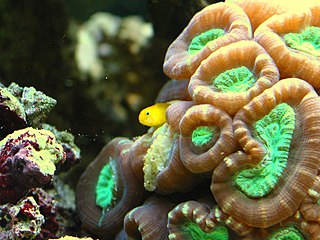 W
WCaulastraea is a genus of stony corals in the family Merulinidae. Species of Caulastraea are commonly found in the aquarium trade under the names candy cane coral or trumpet coral.
 W
WCaulastraea furcata, also known as the candy cane, trumpet, or bullseye coral, is a species of large stony coral in the family Merulinidae.
 W
WCoelastrea is a genus of stony corals in the family Merulinidae. Members of this genus are native to the Indo-Pacific region and their ranges extend from the Red Sea and the east coast of Africa through the Indian Ocean and Western Pacific Ocean as far as Australia, Japan and the East China Sea.
 W
WCoelastrea aspera is a species of stony coral in the family Merulinidae. It is a colonial species native to the Indo-Pacific region where it occurs in shallow water. It was first described by the American zoologist Addison Emery Verrill in 1866 as Goniastrea aspera but it has since been determined that it should be in a different genus and its scientific name has been changed to Coelastrea aspera. This is a common species throughout much of its wide range and the International Union for Conservation of Nature has rated its conservation status as being of "least concern".
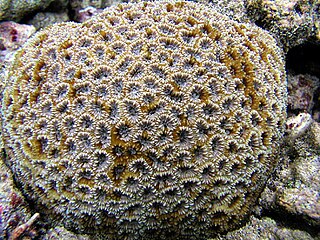 W
WDipsastraea is a genus of stony corals in the family Merulinidae. Members of this genus are native to the Indo-Pacific region. They are zooxanthellate corals.
 W
WDipsastraea pallida is a species of colonial stony coral in the family Merulinidae. It is found in tropical waters of the Indian and Pacific Oceans. This is a common species of coral with a widespread distribution, and the main threat it faces is from the destruction of its coral reef habitats. It is rated as a "least-concern species" by the International Union for Conservation of Nature. This species was first described in 1846 as Favia pallida by the American zoologist James Dwight Dana; it was later transferred to the genus Dipsastraea, but some authorities continue to use the original name.
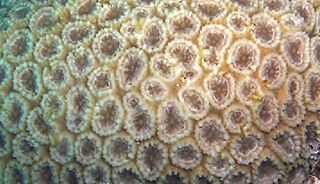 W
WDipsastraea speciosa is a species of colonial stony coral in the family Merulinidae. It is found in tropical waters of the Indian and Pacific oceans.
 W
WEchinopora is a genus of stony corals in the family Merulinidae.
 W
WEchinopora fruticulosa is a species of stony coral in the family Merulinidae.
 W
WFavites is a genus of stony corals in the family Merulinidae. Members of this genus are native to the Indo-Pacific region and their ranges extend from the Red Sea through the Indian Ocean and Western Pacific Ocean as far as Japan, the Line Islands and the Tuamotu Islands.
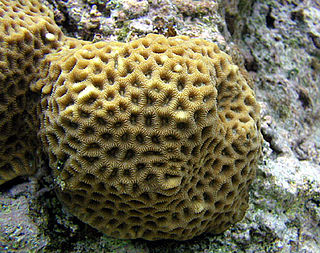 W
WFavites abdita, also known as the larger star coral, is a species of stony coral in the family Merulinidae. It is native to the Indo-Pacific region and its range extends from East Africa and the Red Sea through the Indian Ocean to the Western Pacific Ocean. The International Union for Conservation of Nature has rated its conservation status as being "near-threatened".
 W
WFavites complanata is a species of stony coral in the family Merulinidae, sometimes known as the larger star coral. It is native to the Indo-Pacific region and its range extends from the Red Sea and Indian Ocean to the western and central Pacific Ocean. This is an uncommon species of coral and seems to be decreasing in abundance, and the International Union for Conservation of Nature has rated its conservation status as being "near threatened".
 W
WFavites pentagona is a species of stony coral in the family Merulinidae, sometimes known as larger star coral. It is native to the Indo-Pacific region and its range extends from the Red Sea through the Indian Ocean to the Western Pacific Ocean. This is a common species throughout its wide range and the International Union for Conservation of Nature has rated its conservation status as being of "least concern".
 W
WGoniastrea is a genus of stony corals in the family Merulinidae. Species belonging to the genus Goniastrea forms massive colonies, usually spherical or elongate, with well developed paliform lobes. Polyps can be seen only at night.
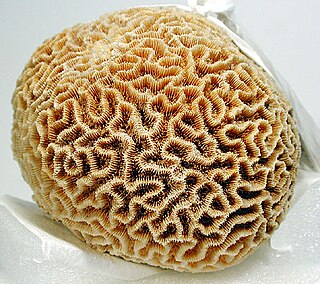 W
WGoniastrea favulus, also known as the lesser star coral, is a species of stony coral in the family Merulinidae. It occurs in shallow water in the Indo-Pacific region. This is an uncommon species of coral and the International Union for Conservation of Nature has rated its conservation status as being "near threatened".
 W
WGoniastrea retiformis is a species of stony corals in the family Merulinidae. It is native to shallow water in the Indo-Pacific region.
 W
WGoniastrea stelligera, commonly known as knob coral, is a species of stony coral in the family Merulinidae. It occurs in shallow water on the coast of East Africa and in the Indo-Pacific region. This is a common species of coral but it seems to be decreasing in abundance. The main threat it faces is from the destruction of its coral reef habitat, and it is also moderately susceptible to coral bleaching, so the International Union for Conservation of Nature has rated its conservation status as being "near threatened".
 W
WHydnophora is a genus of large polyp stony corals in the family Merulinidae.
 W
WHydnophora exesa, also called horn coral or spine coral, is a coral in the genus Hydnophora. It was described by Peter Simon Pallas in 1766.
 W
W W
WLeptoria is a genus of stony corals in the family Merulinidae. Members of this genus are known as brain corals or closed brain corals. They are native to the Indo-Pacific region and their ranges extend from the Red Sea through the Indian Ocean as far as Japan and the South Central Pacific Ocean.
 W
WMerulina is a genus of stony corals in the family Merulinidae. Members of this genus are native to the Indo-Pacific region and their ranges extend from the Red Sea through the Indian Ocean as far as Japan and the southern central Pacific Ocean. Merulina ampliata is the type species.
 W
WThe open brain coral is a brightly colored free-living coral species in the family Merulinidae. It is the only species in the monotypic genus Trachyphyllia and can be found throughout the Indo-Pacific.
 W
WOrbicella annularis, commonly known as the boulder star coral, is a species of coral that lives in the western Atlantic Ocean and is the most thoroughly studied and most abundant species of reef-building coral in the Caribbean to date. It also has a comprehensive fossil record within the Caribbean. This species complex has long been considered a generalist that exists at depths between 0 and 80 meters that grew into varying colony shapes in response to differing light conditions. Only recently with the help of molecular techniques has O. annularis been shown to be a complex of at least three separate species. Those species are divided into O. annularis, O. faveolata, and O. franksi. This coral was originally described as Montastraea annularis.
 W
WOrbicella faveolata, commonly known as mountainous star coral, is a colonial stony coral in the family Merulinidae. It is native to the Caribbean Sea and the Gulf of Mexico and is listed as "endangered" by the International Union for Conservation of Nature. This species was formerly known as Montastraea faveolata.
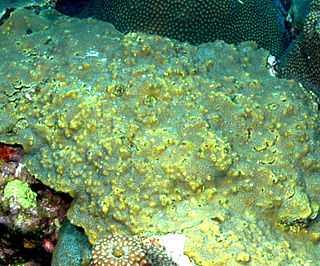 W
WOrbicella franksi, commonly known as boulder star coral, is a colonial stony coral in the family Merulinidae. It is native to shallow waters in the Caribbean Sea, the Gulf of Mexico, the Bahamas, Bermuda and Florida, and is listed as a "vulnerable species" by the International Union for Conservation of Nature.
 W
WOulophyllia is a genus of stony corals in the family Merulinidae. Members of this genus are native to the tropical western and central Indo-Pacific region.
 W
WOulophyllia crispa, sometimes called the intermediate valley coral, is a species of stony coral in the family Merulinidae. It is native to the tropical western and central Indo-Pacific region. Although this coral has a wide range, it is generally uncommon and seems to be decreasing in abundance, and the International Union for Conservation of Nature has rated its conservation status as being "near threatened".
 W
WParagoniastrea is a genus of stony corals in the family Merulinidae.
 W
WParagoniastrea australensis, also known as the lesser star coral, is a species of stony corals in the family Merulinidae. It occurs in shallow water in the Indo-Pacific region.
 W
WPlatygyra is a genus of stony corals in the family Merulinidae.
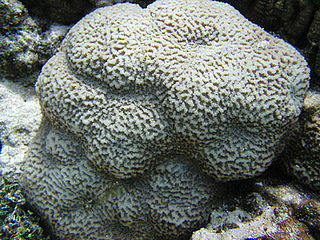 W
WPlatygyra contorta is a species of colonial stony coral in the family Merulinidae. It was described by John Veron in 1990. It is found at depths of 2 to 20 metres and its colonies are over 1 metre (3.3 ft) in diameter. It has been identified as a least-concern species.
 W
WPlatygyra daedalea, sometimes known as the lesser valley coral, is a colonial species of stony coral in the family Merulinidae. It occurs on reefs in shallow water in the Indo-Pacific region. It is a common species and the International Union for Conservation of Nature has assessed its conservation status as being of "least concern".
 W
WPlatygyra lamellina, the hard brain coral, is a species of colonial stony coral in the family Merulinidae. It occurs on reefs in shallow water in the Indo-Pacific region. The International Union for Conservation of Nature has assessed its conservation status as being "near threatened".